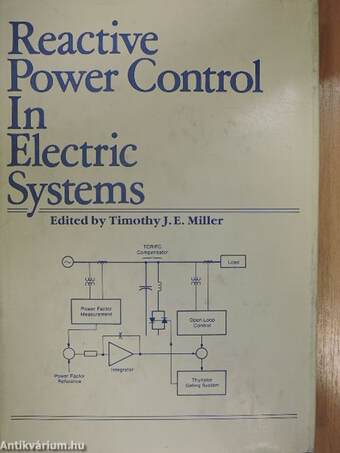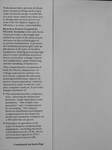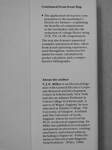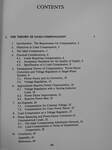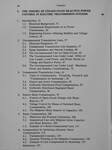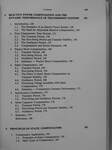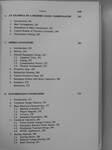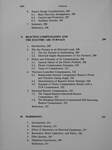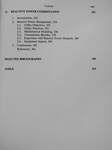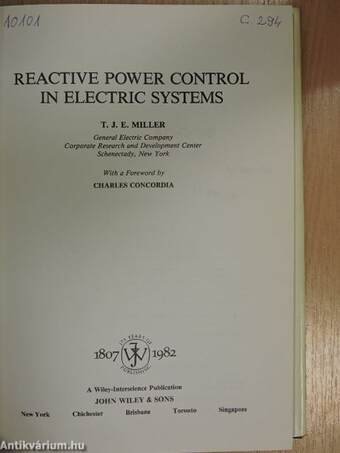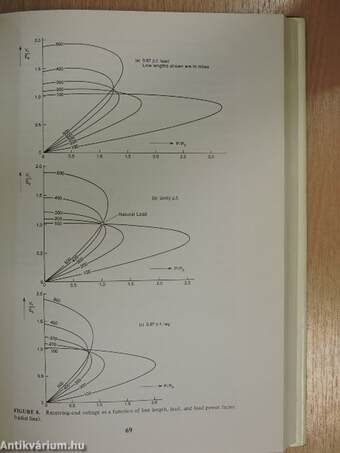1.116.774
kiadvánnyal nyújtjuk Magyarország legnagyobb antikvár könyv-kínálatát
Reactive power control in electric systems
| Kiadó: | John Wiley & Sons, Inc. |
|---|---|
| Kiadás helye: | New York |
| Kiadás éve: | |
| Kötés típusa: | Fűzött keménykötés |
| Oldalszám: | 381 oldal |
| Sorozatcím: | |
| Kötetszám: | |
| Nyelv: | Angol |
| Méret: | 24 cm x 17 cm |
| ISBN: | 0-471-86933-3 |
| Megjegyzés: | Fekete-fehér fotókkal, illusztrációkkal. További kapcsolódó személyek a könyvben. |
naponta értesítjük a beérkező friss
kiadványokról
naponta értesítjük a beérkező friss
kiadványokról
Fülszöveg
With about thirty percent of all primary resources being used to generate electrical energy worldwide, it is now more important than ever to design and operate power systems with the highest degree of efficiency, security, and reliability.
Reactive Power Control in Electric Systems is the only book which provides a thorough and unified account of the most recent advances in the technologies of ac power transmission. It presents the fundamental principles and applications of all types of modern equipment, helping practicing engineers to solve problems in power-factor correction, voltage control and stabilization, phase balancing, and the handling of harmonics. This comprehensive treatment of both the theory and practice of voltage and reactive power control clearly explains the physical meaning behind many aspects of power system operation, which is obscured in other works by complex computer analysis. It provides unique treatment of:
• The transmission line compensation—showing... Tovább
Fülszöveg
With about thirty percent of all primary resources being used to generate electrical energy worldwide, it is now more important than ever to design and operate power systems with the highest degree of efficiency, security, and reliability.
Reactive Power Control in Electric Systems is the only book which provides a thorough and unified account of the most recent advances in the technologies of ac power transmission. It presents the fundamental principles and applications of all types of modern equipment, helping practicing engineers to solve problems in power-factor correction, voltage control and stabilization, phase balancing, and the handling of harmonics. This comprehensive treatment of both the theory and practice of voltage and reactive power control clearly explains the physical meaning behind many aspects of power system operation, which is obscured in other works by complex computer analysis. It provides unique treatment of:
• The transmission line compensation—showing the distinction between "surge impedance compensation," "line length compensation" and "compensation by sectioning." The relation between distributed and lumped compensation is developed in detail and consistent examples on a 200-mile line are given.
• Principles of operation of all types of modern compensating equipment—including thyristor controlled reactors (TCR), thyristor switched capacitors (TSC) and saturated reactors (SR).
Continued on back flap
Continued from front flap
• The application of reactive compensation to the steelmaker's electric arc furnace—explaining the benefits of compensation to the steelmaker and also the reduction of voltage flicker using TCR, TSC or SR compensators.
The text also features numerical examples and practical data, taken from actual operating experience, used throughout, numerous formulas for ready calculation by pocket calculator, and a comprehensive bibliography.
About the author T.J. E. Miller is an Electrical Engineer with General Electric's Corporate Research and Development Center in Schenectady, New York and also an Adjunct Professor at Union College in Schenectady. A native of Wigan, England, he was educated at Atlantic College, The University of Glasgow, Scotland and The University of Leeds, England, where he received his Ph.D. in electrical engineering. Dr. Miller has published several papers and patents in electronics, rotating machinery, and related subjects, including a chapter in "Finite Elements in Electrical and Magnetic Field Problems" (Wiley, 1980). Vissza
Témakörök
Megvásárolható példányok
Nincs megvásárolható példány
A könyv összes megrendelhető példánya elfogyott. Ha kívánja, előjegyezheti a könyvet, és amint a könyv egy újabb példánya elérhető lesz, értesítjük.


